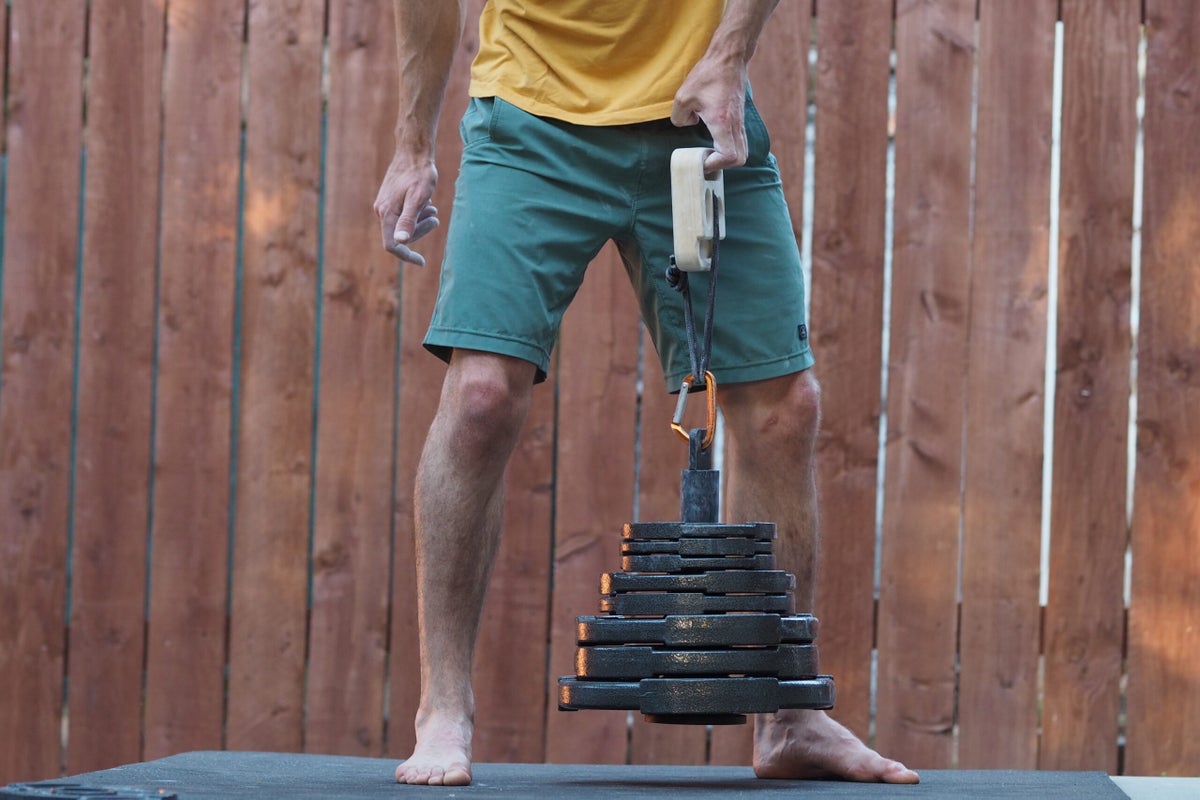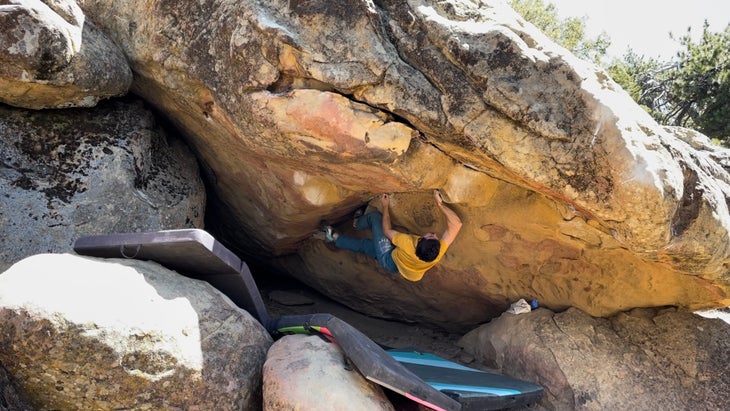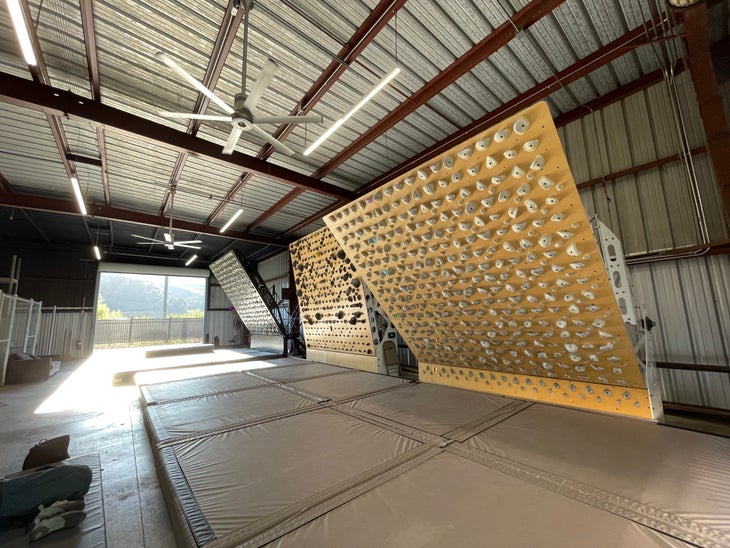I Took Matt Fultz’s Training Program and Saw Surprisingly Quick Gains

Our Thoughts
These days, it seems as if every strong climber works a side hustle as a coach, and there’s no shortage of remote training programs. Matt Fultz, however, isn’t just another pro who’s pivoted to coaching. His passion for training stems back to 2001 when he first started climbing. There weren’t many teams, coaches, or mentors where he lived (first in Indiana, then in Idaho), so he had to learn on the fly. That drive led him to getting a degree in exercise science—and it’s clearly served him well with his own climbing. Fultz’s education, combined with his compassion and more than two decades of experience, is Off the Ground’s recipe for success.
Fultz kindly let me test his flagship APEX training program, which included a fully personalized training plan, video analysis, and daily direct messaging with Matt, along with nutrition coaching from Hailey. I tested the plan for six weeks, and, despite the very short timespan, I saw incremental gains in my workouts from week to week, plus some surprising improvements in my testing scores. Most importantly, my body felt great throughout the training. I was recovering adequately between workouts and maintaining good energy levels, which I can attribute to Matt’s skilled programming paired with Hailey’s nutrition recommendations.

About the Tester
I grew up in the Northeast, where the rock season lasts a full two months if we’re lucky. Winters are long and cold and for ice climbing. Spring is frustratingly wet. Summers are stymied by humidity and black flies. But in the fall, there is generally a glorious month or two with perfectly dry, crisp conditions. Growing up, those were the days I lived for—and in the dark epochs between seasons, I trained.
Training for climbing has been a continuous thread through my life. It led me to a job at Rock and Ice (R.I.P.), then to a role as a fitness columnist for Outside magazine, which gave me an excuse to pick the brains of top coaches, PTs, and athletes the world over. When friends started asking for training advice, those informal sessions evolved into official clinics and a professional coaching gig. I’m not coaching much anymore, but I’m still training, so when Climbing mag asked me to test Matt Fultz’s program, I jumped at the opportunity to let another coach take the reins.
While most of us mortals with desk jobs (myself included) will never match Fultz’s V16 level we can still get joy from seeing continuous improvement over time—and the most efficient way to generate those gains on a busy schedule is to engage in structured training.

An Inside Look at Fultz’s Off the Ground training programs
Pick a program
OTG offers several training programs and plans designed to improve bouldering or sport climbing potential while building injury resilience. All options run on a flexible monthly basis. They range in price from $99 to $299 per month and vary based on the level of personalization. The premium APEX and Performance Ready plans include nutrition coaching, though it can also be purchased as a standalone for $99 per month.
The personalized training programs start at $200 per month with the Focus tier. Apex—OTG’s flagship program and the one we tested for this review—combines the Focus plan with nutrition coaching. You can also upgrade to the Performance Ready plan for $299 per month, which is an Apex plus a monthly 30-minute phone call with Matt and Hailey to talk about your goals, projects, and next steps. Lower tiers include the Boost plan, a pre-written training regimen with video reviews and messaging, and the Siege plan, a pre-written program designed to supplement an outdoor performance climbing-season. Both cost $99.
Matt Fultz writes all of the individualized training programs while Hailey Fultz tackles the nutrition side. A benefit to a small organization like OTG is that you know exactly who will be coaching you before you commit, which isn’t always the case with other training companies.
Onboarding process
Once you select a plan, you start by filling out a survey on your climbing interests, past and present injuries, access to training equipment, short- and long-term goals, training history, and scheduling. If you opted for the nutrition add-on, you’ll complete a second form, with questions on height, weight, body fat estimate, goals, food allergies and restrictions, and diet and eating habits. Each takes upwards of 30 minutes to complete. When you submit the forms, OTG promises to respond within 48 hours, but Matt responded to me in less than 24, following up with a TrueCoach account invitation and information about testing week.
Strength assessment and analysis
A lot of people dread fitness tests, but OTG’s isn’t something you should fear. Fultz has everyone complete the same assessment, spread across a full week, which is divided into four individual testing days, two rest days, and one flexible day. Climbers repeat the same assessment at the end of each training cycle to measure progress.
Each testing day focuses on a specific attribute—such as strength, fingers, or movement and technique—which makes the setup and logistics easy. Each day typically involves only three to four exercises, with time to spare for open climbing. These exercises include everything from max pull-ups and standard 20mm deadhangs to OTG’s namesake “Off the Ground” lifts.
I completed the prescribed exercises each day within the duration of an average gym session, and I finished feeling satisfyingly fatigued, but not completely wrecked. My one mistake, however, was attempting to do the OTG day at home. Despite hitching together every kettlebell, dumbbell, and odd weight that I could find, I ran out before I could reach my max. So a word of advice: read the descriptions beforehand and make sure you have all the necessary tools at your disposal.
Meanwhile, to get a sense of your average nutritional intake, Hailey has you log everything you consume for four days (three training days, one rest day) using a nutrition tracking app.
Once your testing is complete, Matt sends an analysis and your first few weeks of programming—and he does so within a day or two, which is impressively fast.
From my experience, his analysis felt thorough and nuanced and included a nice combination of positive feedback and criticism. I was particularly impressed with the climbing video review, where he used a compliment sandwich formula to point out what I was doing wrong without damaging my ego. He called out my strengths along with my areas for improvement, and recommended key areas for focus in the coming months, while keeping my strengths on the backburner for consistency.

Delivery and communication
OTG uses the TrueCoach app (which is free for clients) to send training programs, communicate through messages, review videos, and manage billing. While it’s nice to have everything in one place, I’m not a huge fan of the app overall.
First of all, the interface just feels clunky. Workouts are organized chronologically, which makes it challenging to find past exercises when you need to repeat a workout or check the previous load. Secondly, the exercise descriptions are in paragraph format (versus a table with set/rep protocols), which is harder to quickly digest mid-workout. Same goes for the results. You must log everything in paragraph format instead of simply punching numbers into a table.
That said, Fultz’s exercise descriptions, often accompanied by demo videos, were clear and concise. And when I wasn’t sure about something, I could always ask since OTG allows daily messaging through the app. Fultz only requests that you give him 24 hours to respond, which seems more than fair, since he’s a one-coach show and a climber himself. In my experience, Fultz always responded within 24 hours, and often within a few hours.
The nutrition communication with Hailey is mostly conducted over email, along with any nutrition tracking app. (She recommends MyFitnessPal, which has a free version). The nutrition coaching also involves a weekly email check in during which the climber answers half a dozen reflection questions and Hailey responds at length. She also sends a steady stream of PDFs with nutritional information, meal prep ideas, and other tips.

Training structure and workouts
Fultz typically structures his programs into 12-week cycles, broken down into blocks with specific areas of focus, such as capacity, power endurance, strength and power, board work, non-linear pre-performance, and linear pre-performance. Each training program is individualized, so where you begin depends on your initial assessment, goals, and timeline. While I didn’t get to experience the whole shebang for the purpose of this review, I did get a six-week snapshot.
During my program, each week of training had a nice balance of workouts, rest days, active rest days at home, and flexible days when I could choose between a few options (rest, projecting, repeating a workout), depending on how I was feeling. The time commitment ranged between 6 to 10 hours per week, and felt manageable for me as a 9-to-5 weekend warrior.
Fultz designed individual workouts around a specific training stimulus, such as strength, climbing stamina, or movement, which made them pretty efficient. I could complete an entire session in the weight room one day and another on a systems board the next. The average workout took less than two hours—or roughly the same amount of time as a typical gym session.
The training volume felt on target for me—I was recovering adequately between workouts and maintaining good energy levels. Overall, the programming felt well matched to my level, goals, and schedule.
There were no official check-in calls with the coach (for that, you’d need to upgrade to the Performance Ready plan), but Matt allows daily messaging and video review, which felt adequate to me, though climbers going through their first structured training plans might benefit from occasional in-person calls. He also occasionally reached out to see how I was getting along.
Nutrition coaching
This was a new experience for me. I generally eat pretty healthy and have been fortunate enough to never worry about my diet or weight, so I haven’t paid much attention to macros and calories before.
As mentioned above, during the first-week nutrition assessment, Hailey asked me to log four full days of nutrition—everything I ate or drank, down to the calorie—so she could get a sense of my baseline diet. After that I reduced logging to a couple of days per week as I responded to Hailey’s advice about my needs. The idea, here, is that you can learn as you go versus following a strict meal plan. There’s no one-size-fits-all recipe, afterall.
Logging nutrition was far harder and more time consuming than I imagined. The more complex the meal, the harder it was to calculate. How many grams of protein were in this taco? What’s in a little dash of adobo sauce? Does it even matter? I confess that my estimates were, at times, far from accurate.
There was also a real learning curve for me here, and, at first, I felt I was drinking straight from a fire hose of nutritional information. Hailey’s feedback emails often ran as long as 1,500 words, with five to seven PDF attachments, which usually contained bright, multi-colored fonts and highlighting. It was all… a bit hard to digest.
Nevertheless, Hailey, a certified sport nutrition coach through the National Association of Sports Medicine, was patient and encouraging. Her feedback never felt judgemental—even when I logged the same NYT’s slow cooker chipotle-honey chicken tacos three meals in a row, because, leftovers. And when I ate an entire box of Annie’s mac and cheese (no veggies! no protein!), she responded, “Matt likes this kind of macaroni, too,” before suggesting I add some steamed broccoli next time.
The traditional problem with eating healthily, at least for me, is time. After a long day of work, the commute to the gym, a two-hour training session, and the commute home, I often won’t start cooking until 8 or 9 pm, at which point I’m focusing less on quality than on convenience. I know what I’m eating isn’t ideal, but in those moments I don’t have the bandwidth for anything else. Hailey understood this, however, and frequently encouraged me to “focus on progress, not perfection,” which was helpful. (I now steam the broccoli some of the time.) And, overall, I felt like she listened to my goals and gave me valuable insights for areas of improvement, particularly when it comes to things like optimal protein timing, time-saving meal prep tips, and easy on-the-go recipes for climbing trips.
I fully respect that nutrition is an important piece to the puzzle; I also recognize that life-long habits are hard to change. My one wish for the nutrition coaching was that I had had more time and mental energy to put into it. Over a longer duration, I think Hailey’s feedback would have had more time to simmer.
My results from Off The Ground’s program
I tested the OTG Apex training program for six weeks, which included an initial testing week and a retesting week at the end, so I only experienced four weeks of dedicated training, which is a very short amount of time to see tangible results in my climbing performance. But I nonetheless saw incremental gains in the exercises from week to week and some surprising improvements in my final testing scores.
I saw the greatest gains in strength endurance, which is unsurprising because it was one of my areas of focus and is a type of adaptation that tends to come faster than something like max strength or finger strength, which were my existing strengths and take longer to develop. For example, on the two-handed 15 mm deadhang test (a bodyweight hang for max duration), I managed 60 seconds the first time around and 70 seconds after four weeks of training—an increase of 16 percent. But with the 20 mm deadhang test (max load, 5 second hold), I went from +132 pounds to +135 pounds—only a 2.3 percent increase.
Most importantly, however, my body felt great throughout the training, with no aches and pains or injuries. One of the most challenging things about coaching other climbers is getting the stress-rest balance right. I felt like Matt did a great job ensuring that I had a good ratio of exercise to recovery, and I think I can attribute my high energy levels in part to Hailey’s nutrition recommendations. (Matt said he and Hailey often work at the same table and chat about athletes together, which is certainly an added benefit to OTG.)
Lastly, I’ve been climbing in all styles for over 15 years, and I thought my technique was pretty dialed. But Matt still found areas for improvement, which has given me a better awareness of my body and movement overall, and I’ll continue to carry that forward.
If I had more time in the program, I’m confident I would have seen further gains, and also see those improvements translate to the rock. And maybe, just maybe, I would have been able to take down an old nemesis project or two.

Who is Off the Ground training for?
OTG is ideal for boulderers and sport climbers with a performance-oriented mindset, particularly those who have an interest in combining training with nutrition. While they do cater to all skill levels, experienced climbers will likely get more out of the program.
The time commitment ranges from 6 to 10 hours per week, with the average workout taking one to two hours, which feels reasonable for those who hold down a full-time job. Each week also has a nice balance of strength workouts and on-the-wall exercises, board climbing, movement work, or open climbing at the end, satisfying those who are always itching to climb.
The flexible month-to-month commitment makes it easy to join, cancel, or pause and restart seasonally, so you can fit the training into your life, as needed (i.e. train through the heat of summer to be ready to send in the autumn).
The ideal training setup includes access to a modern climbing gym or a home wall, hangboard, crimp/pinch block, and free weights (preferably a barbell, although dumbbells can work). But Fultz says he can create a program around personal constraints, which he commonly did during the pandemic lockdowns.
Bottom line: Matt and Hailey Fultz know what they’re doing
Off the Ground’s Apex training program is well designed for intrinsically motivated boulders and sport climbers who want to push their performance to the next level. The training itself feels highly individualized—the right intensity and volume for one’s current fitness, based on one’s goals—and has a nice balance of off-the-wall workouts and actual climbing.
Matt Fultz not only brings decades of hard bouldering experience to his coaching, he’s also a strong communicator who makes himself readily available for questions and personalized feedback.
The combined training and nutrition coaching, spearheaded by Hailey Fultz, is a huge benefit, because if you can recover more efficiently and have more productive sessions, you can absorb more quality training stimulus, which ultimately leads to more sends. The caveat is that it does take extra time and mental effort, at least at first, so you need the bandwidth to take full advantage of it.
Overall, the fully individualized training, ongoing video review, and direct access to responsive coaches make the program a high value for a reasonable price. Plus, the flexible month-to-month commitment makes it a great option for those who want to get in shape for climbing season or tune up before a climbing trip.
The post I Took Matt Fultz’s Training Program and Saw Surprisingly Quick Gains appeared first on Climbing.

